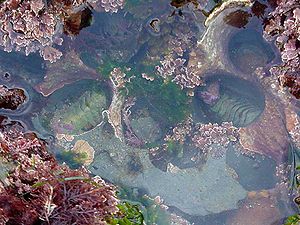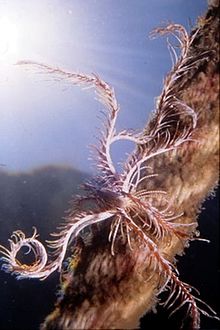User:Nwbeeson/sandbox/PlutoRefs


The Mesozoic Marine Revolution (MMR) is the rapid adaption to shell-crushing (durophagous) and boring predation in benthic organisms throughout the Mesozoic era (242 Mya to 62 Mya). The term was first coined by Geerat J. Vermeij, who based his work on that of Steven M. Stanley.[1][2][3] While initially restricted to the Late Cretaceous (145 Mya to 66 Mya), more recent studies have suggested that the beginning of this ecological arms race extends back into the Norian (Late Triassic)[4] It is the important transition between the Palaeozoic evolutionary fauna and the Cenozoic evolutionary fauna that occurred throughout the Mesozoic.
The Mesozoic Marine Revolution was not the first bout of increased predation pressure; this also occurred around the end of the Ordovician.[5]
There appears to be some evidence of adaption to durophagy during the Palaeozoic, particularly in crinoids.[6]
Causes
[edit]
The Mesozoic Marine Revolution was driven by the evolution of shell-crushing behaviour among Mesozoic marine predators, the technique being perfected in the Late Cretaceous. This forced shelled marine invertebrates to develop defences against this mode of predation or be wiped out. The consequences of this can be seen in many invertebrates today. Such predators are thought to include: Triassic placodonts, Triassic ichthyosaurs, Omphalosaurus, Late Cretaceous mosasaurs and Cretaceous ptycodontoid sharks.[1]
It is also thought that the break-up of Pangaea throughout the Mesozoic brought together previously isolated communities, forcing them to adapt. The increased shelf space caused by sea-level rise and a hyper-greenhouse climate provided more iterations and chances to evolve, resulting in increasing diversity.[1]
Another proposal is the evolution of hermit crabs. These exploit the shells of dead gastropods, effectively doubling the life-span of the shell. This allows durophagous predators nearly twice the prey, making it a viable niche to exploit.[1]
Effects
[edit]The net result of the Mesozoic Marine Revolution was a change from the sedentary epifaunal mode of life of the Palaeozoic Evolutionary Fauna to the infaunal/planktonic mode of life of the Modern Evolutionary Fauna.[3] Non-mobile types that failed to re-attach to their substrate (such as brachiopods) when removed were picked off as easy prey, whereas those that could hide from predation or be mobile enough to escape had an evolutionary advantage.[1]
Three major trends can be associated with this: 1) Reduction in suspension feeding epifauna 2) Increasing abundance of infauna 3) An intermediate stage of mobile epifauna.[7]
Major casualties of the Mesozoic Marine Revolution include: sessile crinoids, gastropods, brachiopods and epifaunal bivalves.
Affected Taxa
[edit]
Gastropods
[edit]Benthic gastropods were heavily preyed upon throughout the MMR, the weaker shelled types being pushed out of the benthic zone into more isolated habitats. The Palaeozoic archaeogastropods were subsequently replaced by neritaceans, mesogastropods and neogastropods.[1] The former typically have symmetrical, umbilicate shells that are mechanically weaker than the latter. These lack an umbilicus and also developed the ability to modify the interior of their shells, allowing them to develop sculptures on their exterior to act as defence against predators.[1]
Another development among Muricidae was the ability to bore through shells and consume prey. These marks (while relatively rare) generally occur on sessile invertebrates, implying that they put pressure on Palaeozoic-type faunas during the MMR [8]
Crinoids
[edit]The MMR heavily affected the crinoids, making the majority of forms extinct. Their sessile nature made them easy prey for durophagous predators since the Triassic.[4] Survivors (such as the comatulids) could swim or crawl, behaved nocturnally or had autotomy (the ability to shed limbs in defence).[6]
Due to the distribution of modern crinoids,[clarification needed] it is assumed that they were unable to live in predator-infested shallow waters and as a result were pushed into deeper waters.[9]
Brachiopods
[edit]Brachiopods, the dominant benthic organism of the Palaeozoic, suffered badly during the MMR. Their sessile foot-attached nature made them easy prey to durophagous predators.[1] The fact that they could not re-attach to a substrate if an attack failed meant their chances of survival were slim. Unlike bivalves, brachiopods never adapted to an infaunal habit (excluding lingulids) and so remained vulnerable throughout the MMR.
Bivalves
[edit]Bivalves adapted more readily than the Brachiopods to this transition. The majority of bivalves adopted an infaunal habit, using their siphons to gather nutrients from the sediment-water interface while remaining safe.[1][3] Others like Pecten developed the ability to jump short distance away from predators by contracting their valves.
Like brachiopods, epifaunal varieties of bivalves were predated upon heavily. Among epifaunal types (such as mussels and oysters), the ability to fuse to the substrate made them more difficult to consume for smaller predators. Epifaunal bivalves were predated on heavily pre-Norian but extinction rates diminish after this.[7]
Echinoids
[edit]Echinoids do not suffer major predation (save for general infaunalisation) during the MMR but it is clear from bromalites (fossilised ‘vomit’) that cidaroids were consumed by predators.[10] Echinoids radiate into predatory niches and are thought to have perfected coral grazing in the Late Cretaceous.[1]
Cidaroids also are thought to have contributed to the downfall of the crinoids.[4][clarification needed]
References
[edit]- ^ a b c d e f g h i j Vermeij GJ (1977). "The Mesozoic Marine Revolution: Evidence from Snails, Predators and Grazers". Palaeobiology. 3: 245–258.
- ^ Stanley SM (1974). "What has happened to the articulate brachiopods?". GSA Abstracts with Programs. 8: 966–967.
- ^ a b c Leighton LR, Webb AE, Sawyer JA (2013). "Ecological Effects of the Palaeozoic-Modern faunal transition:Comparing predation on Palaeozoic brachiopods and mollusc". Geology. 41: 275–278. doi:10.1130/g33750.1.
- ^ a b c Salamon MA, Niedzwiedzki R, Gorzelak D, Lach R, Surmik D (2012). "Bromalites from the Middle Triassic of Poland and the rise of the Mesozoic Marine Revolution". Palaeogeography Palaeoclimatology Palaeoecology. 321: 142–150. doi:10.1016/j.palaeo.2012.01.029.
- ^ Vinn, O (2008). "Attempted predation on Early Paleozoic cornulitids". Palaeogeography Palaeoclimatology Palaeoecology. 273: 87. doi:10.1016/j.palaeo.2008.12.004.
- ^ a b Baumiller, T.; Salamon, M.; Gorzelak, P.; Mooi, R.; Messing, C.; Gahn, F. (2010). "Post-Paleozoic crinoid radiation in response to benthic predation preceded the Mesozoic marine revolution". Proceedings of the National Academy of Sciences of the United States of America. 107 (13): 5893–5896. Bibcode:2010PNAS..107.5893B. doi:10.1073/pnas.0914199107. PMC 2851891. PMID 20231453.
- ^ a b Tackett LS, Bottjer DJ (2012). "Faunal Succession of Norian (Late Triassic) level-bottom benthics in the Lombardian basin: Implications for the timing, rate and nature of the early Mesozoic Marine Revolution". PALAIOS. 27: 585–593. doi:10.2110/palo.2012.p12-028r.
{{cite journal}}: Unknown parameter|lastauthoramp=ignored (|name-list-style=suggested) (help) - ^ Harper EM, Forsythe GT, Palmer T (1998). "Taphonomy and the MMR: Preservation masks the Importance of Boring Predators". PALAIOS. 13: 352–360.
- ^ Oji T (1996). "Is predation intensity reduced with increasing depth? Evidence from the west Atlantic stalked crinoid Endoxocrinus parrae (Gervais) and implications for the Mesozoic Marine Revolution". Palaeobiology. 22: 339–351.
- ^ Borczsz T, Zaton M (2013). "The oldest record of predation on echinoids: Evidence from the M. Jurassic of Poland". LETHAIA. 46: 141–145. doi:10.1111/let.12007.
{{cite journal}}: Unknown parameter|lastauthoramp=ignored (|name-list-style=suggested) (help)
